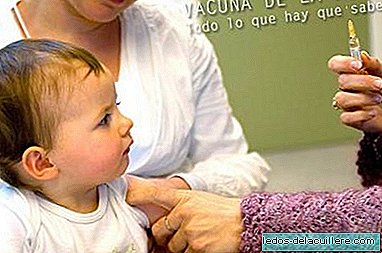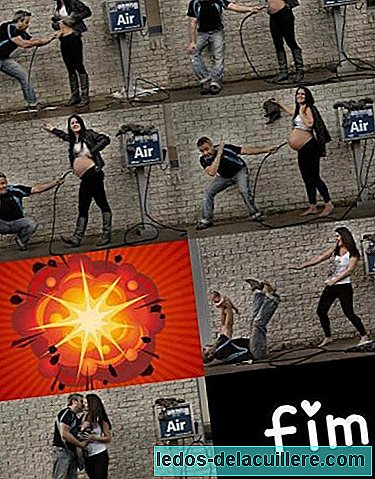
As we have been doing for a few weeks now, in a series of entries in which we explain everything related to childhood vaccines, today we are going to talk about the polio vaccine, which in childhood is combined with other vaccines such as tetanus, diphtheria, whooping cough ... in pentavalent and hexavalent presentations, or loose, alone, for when you only want to administer this vaccine (a child who comes from another country when he is older and there is no possibility of administering childhood vaccines).
The polio vaccine is administered, in childhood, within the hexavalent vaccine, administered at 2, 4 and 6 months, which protects against six diseases: tetanus, diphtheria, poliomyelitis, whooping cough or pertussis, the Haemophilus influenzae type B and hepatitis B. At 18 months, pentavalent is administered, which carries another dose of polio.
It is a vaccine that is administered four times and that does not need any memories, so once administered at those ages (2, 4, 6 and 18 months) there is no need to reapply it. In case a child is over 7 years old and has never been applied, three doses of the vaccine will be sufficient.
What is polio?
It is a disease suffered by many of the adults of the generation that precedes us because there were outbreaks between 1950 and 1964 that could have been minimally controlled with the vaccine, which arrived in Spain in 1955 but was only administered to the children of people close to the Franco regime, in addition to those of employees of large companies. It was not until 1964 that the vaccine was extended to the entire population.
Now, thanks to that, it is very difficult to see new cases of polio, which is a very contagious disease caused by the poliovirus virus, which invades the nervous system and produces paralysis in a matter of hours. It mostly affects children under 5 years.
Contagion occurs through the mouth (respiratory secretions) and oral fecal route, that is, when there is poor hand hygiene. Once the virus enters it may not infect and be asymptomatic (most of the time) or it may enter the central system, pass into the bloodstream and begin to destroy motor nerve cells, causing acute flaccid paralysis. Initial symptoms are fever, fatigue, headache, vomiting, limb pain and stiff neck. One in 200 infected people will suffer irreversible paralysis and between 5% and 10% of these cases die from respiratory muscle paralysis.
How to prevent the disease
Being such a contagious disease the only way to control and avoid it is by vaccination of as many children as possible. The greater the vaccination, the lower the probability that the disease will be contracted and that an outbreak will be generated. It is, in fact, a practically eradicated disease, which is not entirely because outbreaks still appear in countries whose vaccination rate is not high, such as Nigeria, Mali, Afghanistan, Pakistan and India.
Is polio treated?
There is no treatment to cure the disease, but several treatments to alleviate the symptoms of infection. We are talking about using antibiotics if there is urinary infection, moist heat to reduce pain and muscle spasms, analgesia for muscle pain and spasms and physiotherapy, surgery or orthopedic correction treatments to help restore muscle strength and functionality.
Where do you get the vaccine?

Babies, that is, when placed at 2, 4 and 6 months, are given intramuscularly (inside the muscle) in the leg. In the quadriceps, to be more exact. Formerly it was administered in the buttock, but it has been seen that the absorption is worse, with muscles such as deltoids (in the shoulder, but not recommended in babies) and the quadriceps being of choice.
When they are put at 18 months it is usually done in the arm, in the deltoid muscle of the shoulder.
Side effects of polio vaccine
The polio vaccine, when linked to other vaccines, can cause side effects derived from polio, but also from the vaccines that accompanies it. The dose of polio administered alone has few serious side effects, although pain, redness and swelling of the injection site may appear.
The tetanus portion of the vaccine can cause pain and swelling of the injection site, and sometimes a rash that usually disappears within 24 hours. Diphtheria can have the same side effects as tetanus.
When accompanied by pertussis, fever and irritability may occur, and if accompanied by Haemophilus influenza Type B can also give some fever. Although in general, any vaccine can be accompanied by fever.
The occurrence of brain inflammation after the vaccine (I speak of the combined vaccine) but the incidence is very low (1 in 110,000 cases) and it is not known whether it is a reaction to the vaccine or if it is caused by other substances or infections.
Is it related to Sudden Infant Death Syndrome?
As we explained in the previous entries, it is said that the diphtheria and tetanus vaccine, combined with the other vaccines, in this case with polio, could be related to Sudden Infant Death Syndrome (SIDS). But nevertheless, there is no scientific evidence that shows that there is a relationship between one thing and another.
The myth is still alive because the first dose is given at two months, when the risk of SIDS is very high.
Photos | Tom & Katrien, Cory Doctorow on Flickr More information | Medline Plus, VaccinesAEP In Babies and more | 180,000 children die each year from neonatal tetanus, "Vaccines are very effective in preventing disease." Interview with Carlos González (I) and (II), Ten things we should know about vaccines












